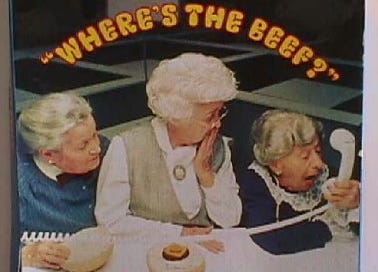“Where’s the beef?!”
I remember this catchy phrase during the 80s when Wendy’s leveraged it to compare the size of its burger patties to its competitors. This slogan was so effective that it increased Wendy’s revenues by 31%. 1
This slogan and associated commercials were an early example of an idea that went viral before the Internet and smartphones. It became so popular the phrase/meme was used during the democratic primaries for the 1984 Presidential election by Walter Mondale to deflate some of the ideas of rival Gary Hart and gain momentum to secure the Democratic nomination. 2
Ironically, for the timing of this newsletter, the “Where’s the beef” advertising slogan started in 1984, and so Wendy’s celebrated the 40th anniversary leading up to the Super Bowl. 3
Transparent Value
This campaign was more than just a way for Wendy’s to more effectively compete with larger rivals like McDonalds and Burger King, it was a cultural statement resonating with society.
In the commercial, not only was the beef patty small it was sandwiched between two oversized buns, which gives off the false impression you are buying a large hamburger. But if you like burgers, who wants to bite into a bunch of dry bread with a tiny beef patty? This imagery targeted McDonald’s Big Mac with two beef patties…but three buns, among other competitors. I’m sure Wendy’s square patties with the four corners sticking out of the bun, helped with the comparative imagery.
However, the illusion of large buns with small patties was not the first criticism of advertising for the hamburger. A more serious deception occurred in the early 1900s when The Jungle was published, exposing how easily ground meat can include scraps, fillers, and other unhealthy ingredients without the final customer being aware of the true nature of the patty when consuming it (except for becoming sick later). The hamburger industry may not be as big as it is today if it were not for White Castle restaurants that focused on cleanliness and transparency. 4
Give me protein and make it yummy
It doesn’t matter if you have massive biceps or not, our bodies need protein as one of the three primary macronutrients (carbs, protein, and fat).
Out of all the three macronutrients and all of the micronutrients, protein is broken down into the amino acid building blocks our bodies need to build and maintain our muscles. Carbs and fat can provide energy stores to move them, but the protein builds.
So we don’t want to skimp on the value of protein sources, whether we dress up that protein as a beef patty smothered in sauces, cheese, and fresh vegetables in a proportioned bun, or as a warm bowl of beans and rice.
The Sandwiched Middle Class
Where is the beef… of the middle class?
Several organizations and authors publish information about the importance of the middle class. One of the components of this newsletter and blog will be focused on the middle class, and so more details about the importance of this group will come later.
However, consider the below snippet from the Pew Research Center. 5
The widening of the income gap and the shrinking of the middle class has led to a steady decrease in the share of U.S. aggregate income held by middle-class households. In 1970, adults in middle-income households accounted for 62% of aggregate income, a share that fell to 42% in 2020.
During the iconic “Where’s-the-Beef” 1980s, the American Middle Class was shrinking.
What if the Middle Class is the protein source for the economy?
If it continues to shrink, sandwiched and hidden between two oversized buns that contain some carbs, but not nothing to build the muscle tissue of the economy, what will our economy look like in the future?
Will our future economy look like the buff, confident tiger above or the small, scared kitten below?







That was an awesome article Nathan. I shared it on FB and invited others to review, share and subscribe. It was very well written, had good points and wasn't too long like some I have seen. I liked the imagery or art work you selected, too.